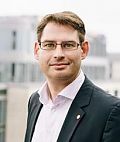Compact CV
Leif Schröder studied physics and chemistry in Göttingen and Heidelberg where he earned his degree in physics in 2001 with studies on in-vivo NMR spectroscopy at the German Cancer Research Center (DKFZ) and in 2003 his doctorate from the Faculty of Mathematics and Natural Sciences. He remained at the DKFZ until he moved to the University of California at Berkeley in 2005 with an Emmy Noether fellowship from the German Research Foundation. During his four-year stay in Berkeley, Leif Schröder worked on novel MR imaging methods based on hyperpolarized xenon biosensors.
In July 2009 he returned to Germany with an Emmy Noether grant from the German Research Foundation. He headed the ERC Starting Grant Project BiosensorImaging in Berlin from 2009-2015 and then a Koselleck project on multivalent xenon MRI reporters. Since 2020 he has been building up the Division of Translational Molecular Imaging at the DKFZ with the support of the Dieter Morszeck Graduation.
His work has been recognized with the Philips Research Award for Medical Physics, the Young Investigator Award of the International Union for Pure and Applied Physics and the Dr. Emil Salzer Prize for Cancer Research.
Leif Schröder is a founding member of the Young Academy of Europe and a member of the International Society for Magnetic Resonance in Medicine, the German Physical Society and the Society of German Chemists.
ORCID Profile: http://orcid.org/0000-0003-4901-0325
Selected Grants:
- PI within the DFG-funded greaduate school BIOQIC: Biophysical Quantitative Imaging Towards Clinical Diagnosis (Förderkennzeichen GRK 2260/1, seit 2017)
- Koselleck grat of the DFG (grant no. SCHR 995/5-1; since 2017, first Koselleck grant to a non-tenured group leader)
- Research Grant of the Michael J. Fox Foundation for Parkinson's Research (project no. 12549)
- Program Grant of the Human Frontiers Science Program (HFSP) together with Prof. M. Shapiro, California Institute of Technology (Project RGP0050/2016; 2016-2020)
- SAW-Grant of the Leibniz-Gemeinschaft (WGL) together with Prof. C. Freund, FMP and FU Berlin (2014-2017)
- Starting Grant of the European Research Council (ERC; first ERC Grant to the Leibniz-Gemeinschaft) (2009-2014)
- Emmy Noether Grant of the DFG (2009)
- Emmy Noether Fellowship of the DFGfor a research project with Prof. David Wemmer and Prof. Alexander Pines, University of California, Berkeley (2005-2007)
- Feodor Lynen Fellowship of the Alexander von Humboldt Foundation (AvH) for a project with Humboldt Awardee Prof. Alexander Pines, University of California, Berkeley (2005)

